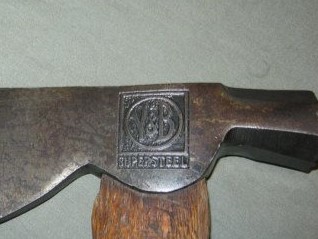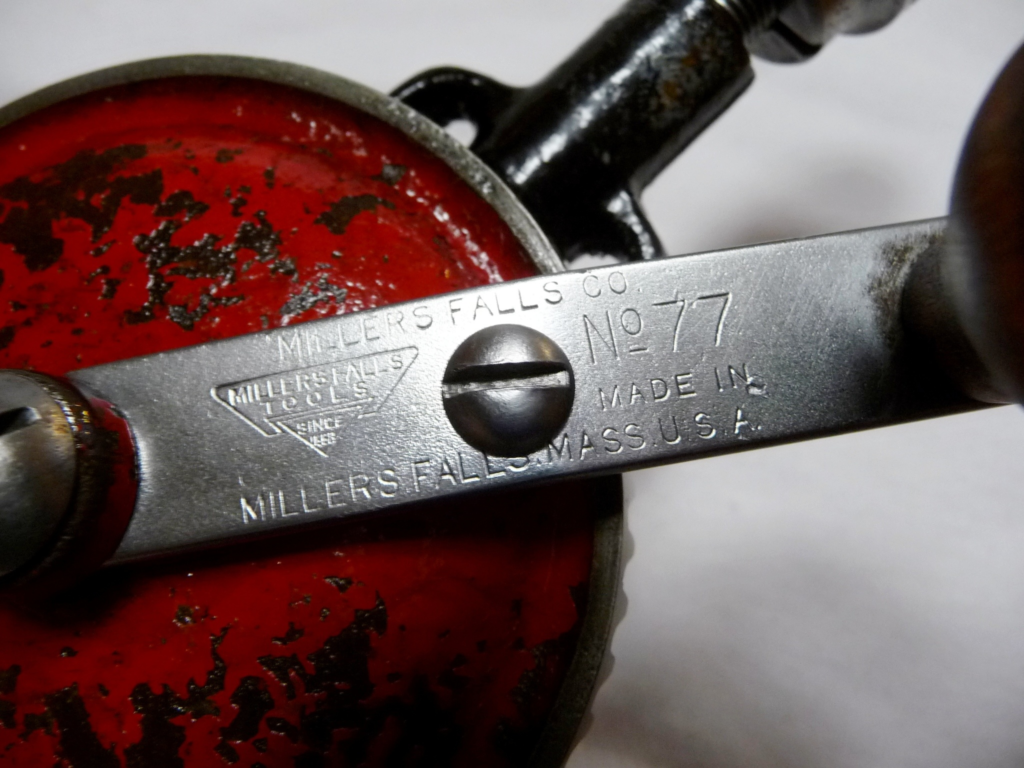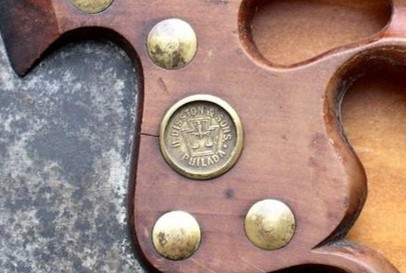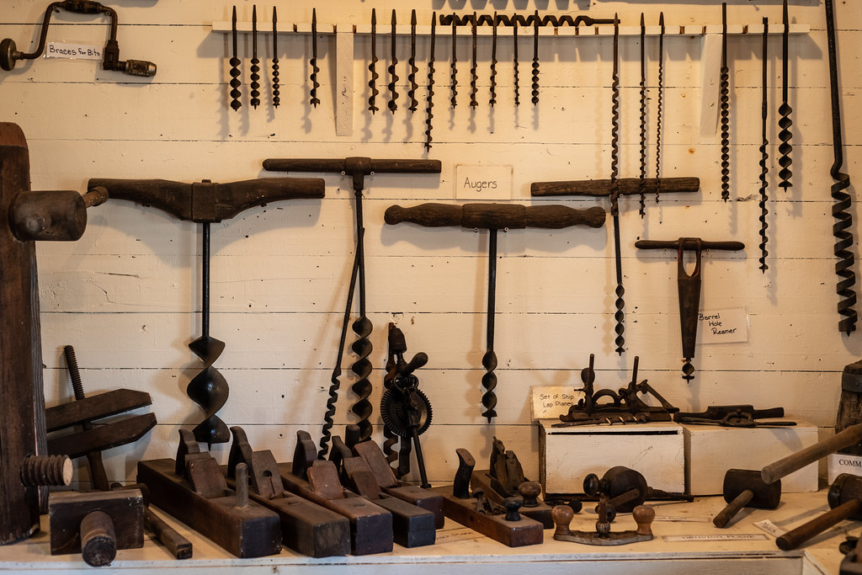Learn the secrets to spotting genuine antique tools, from manufacturer’s marks to signs of wear and tear.

Antique tools exude the charm of a bygone era. With their rustic, well-worn handles and unfinished metal surfaces, they tell a story of the tradespeople who once relied on them as indispensable implements of their work. For antique tool collectors, identifying and authenticating these vintage pieces is an important part of the hobby.
So how do you identify an antique tool and distinguish it from a newer piece or reproduction?
According to the expert vintage appraisal service Appraisily, the best way to identify old vintage tools is to check for manufacturing marks or branding (Look for common vintage tool markers such as Stanley and Miller Falls), look up company patent records, and examine the material the tool is made from.
In this article, we’ll take a more in-depth look at how you can successfully identify old antique tools, along with a few more things you can do to authentic your vintage finds.
Different types of antique tools
There are many different types of antique tools, each with its own unique history and value. Some of the most common types of antique tools include:
- Hand saws
- Planes
- Hammers
- Axes
- Wrenches
- Chisels
- Files
- Levels
- Drills
- Screwdrivers
- Measuring tools
How to Identify Antique Tools
Antique tools are a fascinating window into the past. They can tell us about the tradespeople who used them, the materials and techniques they used, and the history of manufacturing.
Here are some of the main ways you can authenticate old vintage tools.
1. Examining Manufacturer’s Marks
One of the first things to look for when trying to identify antique tools is any manufacturer’s mark stamped into the metal.
The marks on old tools can reveal not just the company that made it, but sometimes the location and exact year of manufacture. This provides collectors with vital clues to the origins and age of antique tools.
For example, tools made in America will often have the manufacturer’s name or initials stamped into the metal along with a city, state, or region.
Some marks also include patent dates which shows when that particular design was registered. Finding a patent date from the 1800s or early 1900s is a clear sign you are looking at an antique tool rather than a reproduction.
Let’s look at some of the most common vintage tool marks to search for:
- Stanley – Founded in 1843, the Stanley Works company produced a huge range of hand tools including levels, rulers, planes, and wrenches. Stanley tools can be identified by the company name stamped into the metal, sometimes with additional registered patent dates.

- Vaughan & Bushnell – Look for the V&B mark on antique hammers and other striking tools made by this manufacturing company which operated from 1869.

- Miller Falls – Established in 1872, the Miller Falls Company produced drills, saws, wrenches and other metal tools stamped with the MF logo. The location may also be included e.g. “Miller Falls, MA”.

- Disston – One of the most recognized names in antique saw-making. Search Disston saws for the etched maker’s mark often accompanied by details of which factory it was made at.

Knowing where to look for marks is also important as they can be stamped in different places depending on the type of tool:
- Planes – Underneath on the main body.
- Hammers/Axes – On the head/blade.
- Saws – Etched onto the blades.
- Levels – Cast into the main frame.
- Wrenches – Either side of the adjustable head.
With experience, antique tool collectors build knowledge of the range of marks used by vintage tool makers. Familiarity with these makes it quicker to identify the age and origins of unmarked antique tools.
2. Researching Patent Records
If you find a patent date stamped on an antique tool, researching the patent records can reveal exactly when that tool design was first registered.
The United States Patent and Trademark Office have an online database allowing you to search for patent records by number, year, inventor name, patent title and more.
Digging into patents around tool designs provides ironclad proof of when that tool dates from. If the patent is from the 19th or early 20th century, it’s a good sign you are looking at a genuine antique rather than a reproduction.
Related articles:
- 15 Best Places To Sell Antique, Vintage, and Old Tools
- The Ultimate List of Vintage Axe Manufacturers
- 15 Best Vintage Tool Brands
- 10 Best Vintage Toolbox Brands
3. Considering Material Composition
The materials used to construct antique tools can also indicate their age and origins.
– Wooden handles on tools like hammers, chisels and planes can hint at provenance based on the type of wood used. Hardwoods like ash, hickory and oak were commonly used on tools made in America and Europe.
Exotic imported woods like ebony were popular for decorative tools like levels and rules during the Victorian era. Simple unfinished wooden handles likely point to an early American folk art tool rather than mass-produced European tools later on.
Metal surfaces also evolved on old tools. The hand-forged iron and steel of 18th and 19th century tools has a much rougher, more textured surface compared to the machined precision of early 20th century mass-produced tools.
Look closely at the finish. Simple blackening using candle soot or linseed oil to prevent rust points to very early antique tools. The introduction of varnishes, japanning and nickel-plating came later.
Understanding these material clues helps narrow down the period an antique tool likely dates from.
4. Evaluating Craftsmanship
As mass-production became more common in the late 19th and early 20th centuries, the individual craftsmanship seen on earlier tools faded.
Examining construction methods can provide clues to age. Evidence of hand-forging metal components or the primitive machining of early industrialization differs noticeably from the uniform precision of 20th century factory tools.
The joinery and finishing of wooden handles also reflects era-specific techniques. For example, dovetail joints traditionally pointed to pre-industrial revolution tools when artisan craftsmanship was at its peak.
Study the tool closely. Buffed edges, uniform machine marks, standardized parts, and replicated decoration tend to indicate a later date of manufacture.
Tools showing unique smithing flaws and irregular hammer marks are more likely to be older antique examples made by blacksmiths or early workshops.
5. Considering Contextual Details
Looking beyond just the physical tool itself, considering what is known about its origins and backstory can also help validate antique status.
Provenance referring to an early ownership or location gives an object history that adds to its legitimacy. Similarly, any documents, catalogs or publications referencing the tool’s age or rarity boosts credibility.
Well-documented history proving a tool has been handled and collected as an antique since early on, helps confirm it is the genuine article and not a later reproduction.
6. Identifying Common Reproduction Techniques
Genuine antique tools have a clear worn and aged patina built up over decades of use. Being able to identify faked aging helps spot modern day reproductions.
Some things to watch out for include:
- Sandblasting – Used to wear down surface paint and metal to mimic antique patina. Look for overly uniform scarring unlike natural aged wear.
- Acid Etching – Can create fake pitting and corrosion marks if metal is treated with acid. The artificial marks appear too precise.
- Staining – Makes wood handles appear aged. Notice if color has penetrated deep into the grain which takes decades to achieve naturally.
- Rusting – Chemicals or even urine (high in ammonia) used to artificially corrode and rust metal. Look for uneven blotchy patches unlike natural oxidation.
- Repairs – Genuine worn parts sometimes swapped for replacements. Unmatched aging of components can be a warning sign.
Spotting these artificial aging techniques takes some experience, but helps avoid paying antique prices for fabricated reproductions.
7. Consulting Collectors Groups
For rare, unusual, or unidentified tools, consulting with knowledgeable antique tool collectors can often provide answers.
Online communities like SawMill Creek or Yesteryear Tools offer reference materials and expert advice on antique tool identification from veteran collectors.
Regional antique tool clubs also represent a wealth of expertise. Members often enjoy the challenge of tracing unidentified tools and can point towards verified comparables.
Well-researched collector reference books focusing on specific tool types also offer invaluable identification resources in pinning down elusive antique tools.
Key Takeaways on Identifying Antique Tools
When trying to authenticate the age and provenance of vintage tools, there are some key factors experts rely on:
- Manufacturer Marks – Search for any stamped logos, names, patent dates, locations indicating origins.
- Materials – Note the types of metal and wood used which can hint at manufacturing processes and age of tool.
- Craftsmanship – Hand-crafted imperfections tend to increase value vs mass-produced uniformity.
- Context – Provenance and backstory validating it as a known antique.
- Aging – Be wary of artificial distressing techniques like staining or pitting to mimic antique wear.
- Collectors Groups – Online forums and clubs offer invaluable reference advice from tool experts.
With experience, identifiable patterns emerge in the materials, branding, aging and wear that point towards genuine well-used antique tools versus manipulated reproductions or retrospectively “antiqued” newer tools.
It’s satisfying to rescue a true antique from obscurity by accurately tracing its roots and restoring it to use. That patina of age reflects a charm and character impossible to replicate on demand. The right identification skills are key to recognizing that hard-won, time-earned authenticity.
Hopefully these tips will help you spot the difference and identify when you have a genuinely historic antique tool in your hands.


